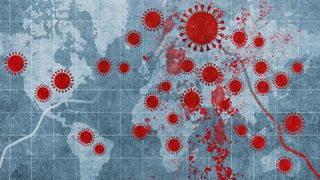
What does it mean for a disease to be 'endemic'?
In the context of a disease, the transition from "epidemic" to "endemic" means a pathogen is no longer causing outbreaks but isn't disappearing.

You may have heard the term "endemic" used to describe diseases, often in comparison with the terms "epidemic" and "pandemic." Many health officials say that COVID-19 is likely transitioning from pandemic to endemic status in many countries. But what does that mean?
More broadly, the term "endemic" refers to an organism that's found in a specific region. In ecology, that means a species that lives only in one geographical area, like a plant or animal limited to an island, according to the U.S. Geological Survey. However, in the context of public health, "endemic" refers to a disease with a constant presence or "usual" number of infections in a specific area, according to the Centers for Disease Control and Prevention.
"The technical definition is a disease that's at a steady state. It's there all the time," Dr. Christopher J. Gill, a professor of global health at Boston University, told Live Science. "It's not really causing outbreaks, and it's not dying away."
That concept, in turn, depends on the idea of an "epidemic" disease — one with greater-than-normal levels of infection in a population, Gypsyamber D'Souza, an epidemiology professor at the Johns Hopkins Bloomberg School of Public Health, told Live Science. (An epidemic disease becomes "pandemic" if it spreads over several countries or the globe.)
Related: The worst epidemics and pandemics in history
Endemic status also depends on the impacts a disease has on society in a particular region, D'Souza said. "It means that there is enough immunity in the population that we have learned to live with that infection," she said. "We don't have surges of disease … that disrupt daily life."
Not every epidemic disease becomes endemic, however; many just disappear. "If you have an epidemic and you successfully contain and treat it and you are able to drive it to zero infections, you can prevent it from becoming endemic," D'Souza said. Examples include the 2005 H5N1 bird flu and the 2002-2004 severe acute respiratory syndrome (SARS) outbreaks.
Sign up for the Live Science daily newsletter now
Get the world’s most fascinating discoveries delivered straight to your inbox.
A host of diseases have become endemic in the U.S., including respiratory illnesses such as flu and respiratory syncytial virus (RSV), as well as many childhood diseases. "Measles, mumps, rubella, chickenpox, group A strep [Streptococci], pink eye — all of these things are just constantly circulating," Gill said. At the beginning of the COVID-19 pandemic, experts wondered whether the disease would rise quickly in prevalence and disappear or eventually become endemic, though most predicted an endemic route, Gill said. At nearly three years into the pandemic, many experts said COVID-19 was endemic in the U.S. or soon to become so, as most people had some immunity from vaccination or exposure, D'Souza said.
The timing of that transition could vary according to the expert, however, as they evaluated how far infection and death levels had fallen. "It's not an exact science," she said. "We're not going to say this exact day is when we have transitioned." Meanwhile, epidemic infection levels may continue in other parts of the world even as a disease becomes endemic in another region.
Experts caution that becoming endemic doesn't necessarily mean less-severe disease, although "generally, we expect pathogens to become less pathogenic over time," Gill said. Similarly, endemicity doesn't mean a disease has ceased to be a public health problem, virologist and immunologist Matt Koci said in a North Carolina State University post. "Smallpox was an endemic disease that consistently killed 1 out of every 3 people it infected," he said.
Rarely, endemic diseases — particularly influenza — can return to epidemic status, Gill said. "Occasionally, the influenza virus can mutate radically into something almost completely unseen by the population," he said. "And then you can have a totally disastrous influenza pandemic," as happened in the 1918 influenza outbreak, in which a new flu strain killed roughly 50 million people.

Michael Dhar is a science editor and writer based in Chicago. He has an MS in bioinformatics from NYU Tandon School of Engineering, an MA in English literature from Columbia University and a BA in English from the University of Iowa. He has written about health and science for Live Science, Scientific American, Space.com, The Fix, Earth.com and others and has edited for the American Medical Association and other organizations.
Most Popular

